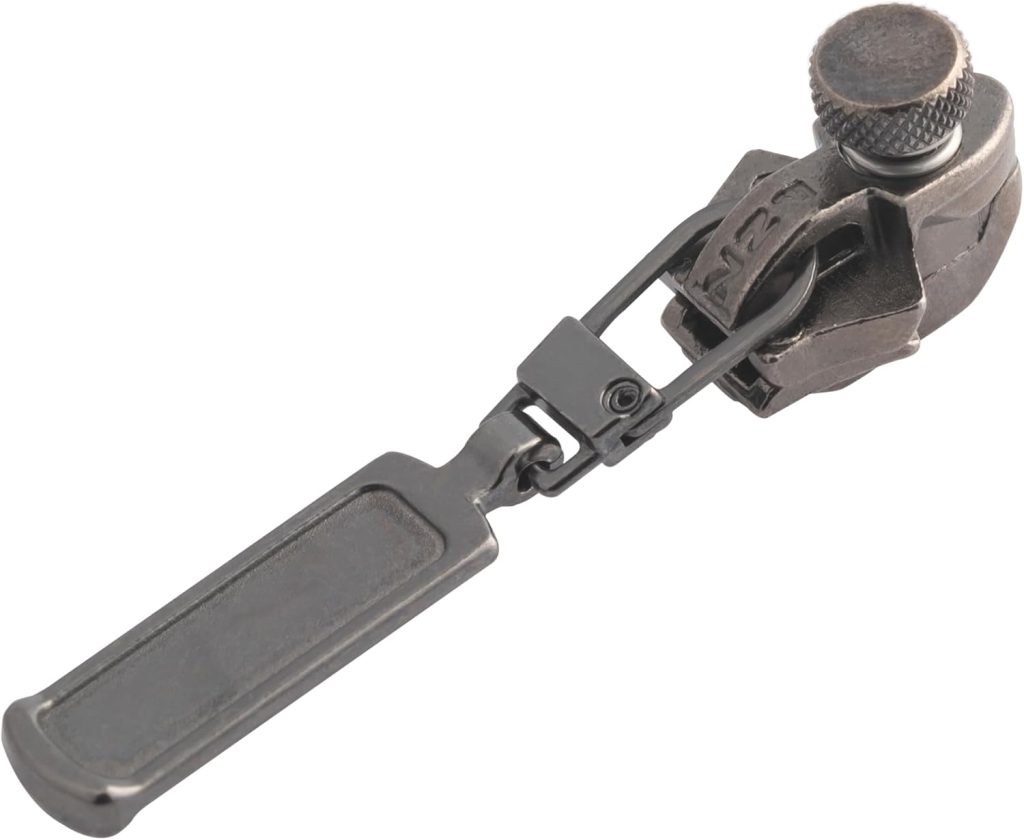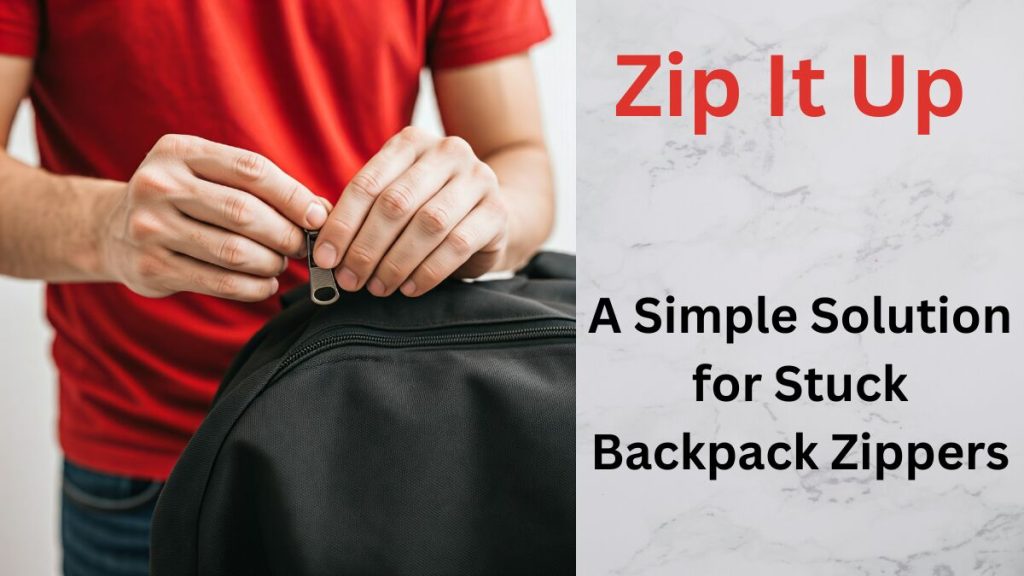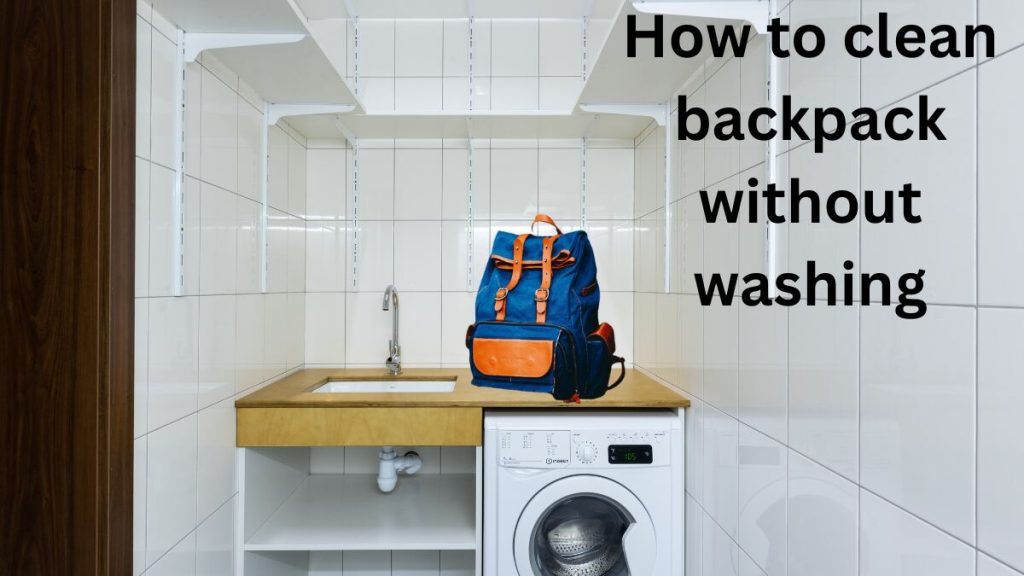Getting a backpack zipper unstuck can be a frustrating experience, especially when you’re in a hurry or on the move. There’s nothing worse than struggling with a jammed zipper when all you want is to grab your belongings. Fortunately, knowing how to get backpack zipper unstuck can save you from potential damage to your bag and help you avoid unnecessary stress. Zippers often get stuck for various reasons, like fabric, thread, or even dirt caught in the teeth. Sometimes, it’s due to corrosion on metal zippers or misaligned teeth, all of which are common yet easily fixable issues.
With a little patience and the right techniques, you can quickly and safely get your zipper moving again. In this guide, we’ll explore practical steps and effective solutions to unstick your backpack zipper using simple household items, such as pencils, soap, or even pliers. Plus, we’ll discuss preventative measures to keep your zippers running smoothly for the long haul. Whether you’re an adventurer, student, or professional, mastering these techniques for fixing a stuck zipper will save you time and keep your backpack in top shape for years to come.
Understanding the Culprit: Why is Your Backpack Zipper Stuck?
A stuck backpack zipper can be a frustrating inconvenience, but understanding the root cause can help you resolve the issue efficiently. By identifying the culprit behind the jammed zipper, you can choose the most appropriate solution to free it up.
Common Causes of Stuck Backpack Zippers:
1. Fabric or Thread Caught in the Teeth:
- Visual Inspection: Carefully examine the zipper teeth for any visible pieces of fabric or thread that might be obstructing the slider’s movement.
- Gentle Extraction: If you spot any trapped fibers, use a pair of tweezers or a needle to gently remove them. Be cautious not to damage the zipper teeth in the process.
2. Dirt and Debris Buildup:
- Cleaning the Zipper: Over time, dirt, dust, and other debris can accumulate in the zipper track, hindering its smooth operation.
- Cleaning Solution: Use a soft-bristled brush or a cotton swab dipped in rubbing alcohol to clean the zipper track and teeth. Gently scrub away any dirt or grime.
- Lubrication: After cleaning, apply a small amount of pencil lead or a silicone-based lubricant to the zipper teeth. This will help reduce friction and ensure smoother movement.
3. Corrosion:
- Metallic Zippers: Metallic zippers are more susceptible to corrosion, especially if exposed to moisture or harsh weather conditions.
- Rust Removal: If you notice signs of rust, carefully clean the zipper with a rust remover or a mixture of white vinegar and baking soda.
- Lubrication: Once the rust is removed, apply a silicone-based lubricant to prevent further corrosion and improve zipper performance.
4. Damaged Zipper Teeth:
- Bent or Broken Teeth: If the zipper teeth are bent or broken, it may be difficult to repair the zipper yourself.
- Professional Repair: In such cases, it’s best to consult a professional tailor or a zipper repair specialist to assess the damage and determine the appropriate repair method.
By carefully examining your stuck backpack zipper and identifying the underlying cause, you can take the necessary steps to resolve the issue and restore your backpack to full functionality. Remember, patience and gentle handling are key to avoiding further damage to the zipper.
Unstucking Your Backpack Zipper: A Step-by-Step Guide to unstuck backpack zipper
A stuck backpack zipper can be a frustrating inconvenience, especially when you’re in a rush. But fear not! With a little patience and the right techniques, you can often resolve the issue yourself. Here’s a step-by-step guide to help you unstuck your backpack zipper:
1. Identify the Problem:
- Jammed Slider: The zipper slider might be stuck, refusing to move up or down.
- Caught Teeth: Fabric or thread could be caught in the zipper teeth, preventing smooth movement.
- Damaged Zipper: The zipper teeth might be broken or bent, making it difficult to operate.
2. Clear Obstructions from the Zipper Teeth:
- Fabric or Thread: If fabric or thread is causing the issue, gently pull the material away from the zipper teeth. Be cautious to avoid damaging the fabric or the zipper itself. For small or stubborn threads, use tweezers to carefully extract them.
- Debris: Dirt, dust, or other debris can accumulate in the zipper teeth and cause friction. Use a soft-bristled brush or a toothpick to gently clean the teeth.
3. Lubricate the Zipper:
- Pencil Graphite: A simple and effective lubricant, pencil graphite can reduce friction and help the zipper slide smoothly. Rub the side of a pencil lead along the zipper teeth, ensuring even coverage.
- Silicone-Based Lubricant Spray: For more stubborn cases, a silicone-based lubricant spray can be used. Apply a small amount to the zipper teeth and slider, then work the zipper back and forth to distribute the lubricant.
- Wax: Beeswax or paraffin wax can also be used as a lubricant. Rub a small amount onto the zipper teeth and slider, then work the zipper back and forth to distribute the wax.
4. Gently Work the Zipper:
- Slow and Steady: Avoid forcing the zipper, as this can damage the teeth or the slider. Instead, gently work the zipper back and forth, applying slight pressure.
- Hot Water: For stubborn zippers, you can try immersing the affected area in hot water. This can soften the material and make it easier to work the zipper. However, be cautious not to scald yourself or damage the backpack’s fabric.
5. Seek Professional Help:
- If the above methods fail to resolve the issue, it may be necessary to seek professional help from a tailor or a repair shop. They can assess the damage and determine the best course of action, which may involve replacing the zipper entirely.
Additional Tips:
- Preventative Maintenance: To minimize the risk of future zipper problems, regularly clean and lubricate your backpack’s zippers.
- Avoid Overloading: Overloading your backpack can put extra strain on the zippers, increasing the likelihood of damage.
- Store Properly: When storing your backpack, avoid folding it in a way that puts pressure on the zippers.
By following these steps and tips, you can effectively address most common backpack zipper issues and restore your bag to full functionality. Remember, patience and gentle handling are key to a successful repair.

Lubricate Your Way to a Smooth Zipper
Once you’ve freed the stuck zipper, it’s crucial to prevent future jamming. Lubrication is the key to ensuring a smooth and hassle-free zip. Here are a few effective methods you can use:
1. Graphite Pencil: A Dry Lubricant
A graphite pencil is a fantastic tool for lubricating zippers. The graphite, a dry lubricant, reduces friction and prevents the teeth from sticking together. Here’s how to use it:
- Identify the Stuck Area: Determine the specific section of the zipper that’s causing the problem.
- Apply Graphite: Gently rub the graphite pencil lead along the teeth of the zipper, focusing on the stuck area.
- Work the Zipper: Slowly move the slider back and forth to distribute the graphite.
Note: While graphite is an excellent dry lubricant, it can attract dirt over time. Therefore, it’s best to use it sparingly and clean the zipper regularly.
2. Soap or Lip Balm: A Gentle Lubricant
For a quick and easy solution, you can use soap or lip balm. These items provide a gentle lubrication that can help the zipper slide smoothly.
- Apply Lubricant: Rub a small amount of soap or lip balm onto the zipper teeth, focusing on the stuck area.
- Work the Zipper: Move the slider back and forth to spread the lubricant and free the zipper.
Note: While soap and lip balm are effective, they can attract dirt and grime over time. It’s advisable to clean the zipper regularly to maintain its performance.
3. Petroleum Jelly or Wax: A Long-Lasting Lubricant
Petroleum jelly or wax offers a long-lasting lubrication that can significantly reduce friction. However, it’s important to use it sparingly to avoid excess buildup.
- Apply Lubricant: Apply a small amount of petroleum jelly or wax to a cotton swab. Gently rub the swab along the zipper teeth, focusing on the stuck area.
- Work the Zipper: Move the slider back and forth to distribute the lubricant and free the zipper.
Note: While petroleum jelly and wax are effective lubricants, they can attract dirt and grime. It’s crucial to clean the zipper regularly to prevent future issues.
Additional Tips for Zipper Maintenance:
- Regular Cleaning: Clean your backpack zipper regularly with a soft cloth and mild detergent to remove dirt and debris.
- Avoid Force: Never force a stuck zipper. This can damage the teeth and lead to further problems.
- Inspect the Zipper: Regularly inspect your zipper for any signs of damage, such as broken teeth or a bent slider.
- Store Your Backpack Properly: Store your backpack in a dry, clean place to prevent moisture and dust from damaging the zipper.
By following these tips and using the appropriate lubrication methods, you can keep your backpack zipper functioning smoothly and avoid future frustrations.
Incorporating Rubbing Alcohol for Metal Zippers
A Clean Zipper, A Smooth Zip
For metal zippers, a bit of cleaning can often do the trick. Rubbing alcohol is an excellent choice for cleaning metal surfaces, as it effectively removes dirt, grime, and corrosion.
Here’s how to use rubbing alcohol to clean your metal zipper:
- Gather Your Supplies:
- Rubbing alcohol
- Cotton balls or soft cloth
- Clean the Zipper:
- Dampen a cotton ball or soft cloth with rubbing alcohol.
- Gently wipe the zipper teeth, paying special attention to any areas that appear dirty or corroded.
- Allow the zipper to air dry completely.
Once the zipper is dry, try moving the slider. The cleaning process should have removed any debris or corrosion that was causing the sticking.
Remember: Always test the rubbing alcohol on a small, inconspicuous area of the zipper first to ensure it doesn’t damage the material.
By following these simple steps and using the appropriate lubrication methods, you can keep your backpack zipper functioning smoothly and avoid future frustrations.
Gentle Wiggles, Smooth Zips
Once you’ve applied the lubricant of your choice, the next step is to gently coax the zipper slider back into action. Here’s how:
- Grasp the Slider Firmly: Hold the zipper slider firmly with your fingers, ensuring a secure grip.
- Apply Gentle Pressure: Apply gentle, consistent pressure to the slider, moving it back and forth. Avoid jerking or pulling the slider forcefully, as this can damage the zipper teeth.
- Wiggle the Slider: While applying pressure, try gently wiggling the slider up and down. This can help to dislodge any debris or misaligned teeth that may be causing the sticking.
- Be Patient: Patience is key when dealing with a stuck zipper. Don’t rush the process. Take your time and let the lubricant work its magic.
Remember: If the zipper is still stuck after several attempts, it’s best to seek professional help or replace the zipper altogether. Forcing a stuck zipper can lead to further damage, making it more difficult to repair.
By following these steps and using the appropriate lubrication methods, you can effectively free a stuck zipper and restore your backpack to full functionality.
A Gentle Hand and a Steady Grip: Fixing unstuck/Bent backpack Zipper Teeth
Sometimes, a stuck zipper can be caused by bent or misaligned teeth. While it may seem daunting, you can often fix this issue yourself with a pair of pliers.
Here’s how to do it:
- Inspect the Zipper: Carefully examine the zipper to identify the bent or misaligned teeth.
- Gather Your Tools: Have a pair of needle-nose pliers ready. These pliers are ideal for delicate work and can help you manipulate the zipper teeth without causing further damage.
- Gently Straighten the Teeth:
- Grip the bent tooth with the pliers, ensuring a firm but gentle hold.
- Slowly and carefully, bend the tooth back into its original position. Avoid using excessive force, as this can break the tooth.
- Repeat this process for any other bent teeth you find.
- Test the Zipper: Once you’ve straightened all the bent teeth, test the zipper to see if it moves smoothly. If the zipper is still stuck, you may need to apply lubrication or seek professional help.
Remember: When working with pliers, it’s important to exercise caution and avoid using excessive force. A gentle touch is often the best approach. If you’re unsure about your ability to fix the zipper, it’s best to consult a professional tailor or repair service.
By following these steps and using the appropriate tools, you can often fix a bent zipper and restore your backpack to full functionality.
Prevent Zippers from Sticking in the Future
A little prevention goes a long way in keeping your backpack zipper functioning smoothly. Here are a few tips to prevent future sticking and prolong the life of your zipper:
- Regular Cleaning:
- Clean your backpack zipper regularly, especially after outdoor activities.
- Use a soft cloth dampened with mild soap and water to remove dirt, grime, and debris.
- Dry the zipper thoroughly with a clean cloth.
- Lubrication:
- Periodically apply a small amount of lubricant to the zipper teeth.
- Graphite pencil, wax, or silicone spray are excellent choices for lubricating zippers.
- Apply the lubricant sparingly to avoid attracting dirt and debris.
- Avoid Force:
- Never force a stuck zipper. This can damage the teeth and lead to further problems.
- If a zipper is stuck, use gentle, consistent pressure and lubrication to free it up.
- Store Your Backpack Properly:
- Store your backpack in a clean, dry place to prevent moisture and dust from damaging the zipper.
By following these simple tips, you can enjoy a smooth-zipping backpack for years to come.
When to Call It Quits: Replacing a Damaged Zipper
Despite your best efforts, sometimes a zipper is simply too damaged to be repaired. If you’ve tried all the above methods and the zipper still refuses to cooperate, it may be time to consider replacing it.
Signs that your zipper needs replacement:
- Severe Damage: If the zipper teeth are severely damaged, broken, or missing, it’s likely beyond repair.
- Broken Slider: A broken or malfunctioning slider can prevent the zipper from functioning properly.
- Persistent Sticking: If the zipper consistently sticks, even after cleaning and lubrication, it may be time for a replacement.
If you decide to replace the zipper, you can either attempt to do it yourself (if you’re skilled in sewing and repairs) or take your backpack to a professional tailor or repair shop.
Remember, a timely zipper replacement can save you from further inconvenience and ensure the longevity of your backpack.
Conclusion: how to get backpack zipper unstuck
In conclusion, knowing how to get a backpack zipper unstuck can save you time and reduce the frustration of dealing with a stubborn zipper. By identifying the cause, carefully removing any obstructions, and applying the right type of lubrication, you can often get a stuck zipper moving smoothly again without causing any damage. Techniques such as using a graphite pencil, soap, or petroleum jelly are effective ways to keep the zipper in top shape, while gently wiggling or realigning the teeth with pliers can resolve even tough jams. Regular maintenance and cleaning of your backpack’s zipper, especially after outdoor use, can prevent these issues from occurring frequently.
Getting familiar with these simple methods means you can handle zipper troubles on the go, ensuring your backpack stays ready whenever you need it. If the zipper remains stuck despite your efforts, it may be time to consider a replacement, as sometimes a broken or heavily corroded zipper can’t be fixed permanently.
We hope this guide has been helpful! If you found it useful, please like and share this post to help others learn how to get a backpack zipper unstuck quickly and efficiently. We’d also love to hear from you—let us know in the comments if you have other zipper-fixing tips or which of these methods worked best for you! Your feedback and ideas are always welcome.





